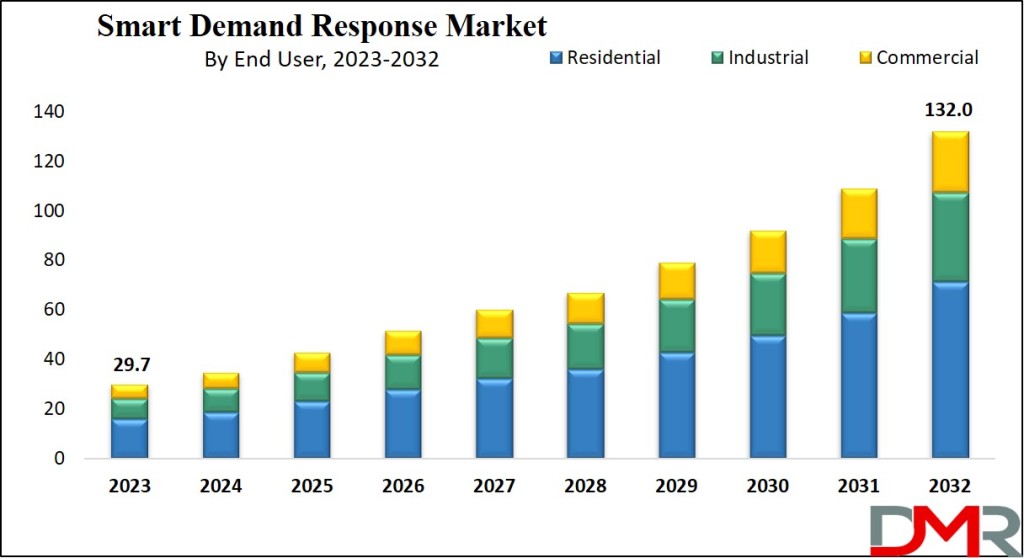Understanding the Smart Demand Response Market: Enhancing Energy Management
In today's rapidly evolving energy landscape, the concept of Smart Demand Response is gaining significant traction. The Global Smart Demand Response Market is expected to reach a value of USD 29.7 billion in 2023, and it is further anticipated to reach a market value of USD 132.0 billion by 2032 at a CAGR of 18.0%. The market has seen a significant increase in the recent past and is predicted to grow significantly during the forecasted period as well.

Request For a Free Sample PDF Copy of This@ https://dimensionmarketresearch.com/report/smart-demand-response-market/request-sample
Smart Demand Response Market Growth Analysis
Market Dynamics
The Smart Demand Response Market has witnessed substantial growth in recent years and is poised for further expansion. Attributed to factors such as the proliferation of smart grid implementations, increasing adoption of renewable energy sources, and favorable policies promoting demand response programs, the market is on an upward trajectory. Initiatives like the Leadership in Energy & Environmental Design (LEED) and government-led incentives are fostering the uptake of smart demand response solutions.
However, challenges such as high initial investments and limited consumer awareness hinder the market growth. Nonetheless, the evolving power sector landscape and the decentralization of electricity systems present promising opportunities for market players.
Research Scope and Analysis
By End User
The market segmentation by end-user reveals interesting insights. Residential applications lead in revenue share, driven by the growing focus on energy efficiency and carbon footprint reduction. Smart demand response solutions empower homeowners to optimize energy consumption, particularly during peak demand periods. The integration of distributed generation and intelligent residential buildings further propels the adoption of demand response programs.
On the other hand, the industrial segment is poised for rapid growth, fueled by the scalability of smart grids and the integration of distributed energy resources (DERs). Industries leverage smart grids to closely monitor and manage energy consumption, with the inclusion of DERs enhancing adaptability and responsiveness.
Commercial demand response is also gaining momentum, driven by utilities' efforts to manage peak energy demands efficiently and advancements in hardware technologies.
Buy This Report Here Click Here@ https://dimensionmarketresearch.com/checkout/smart-demand-response-market
Key Takeaways:
- Smart Demand Response Market Growth: The Smart Demand Response Market is witnessing substantial growth driven by factors such as smart grid implementations, renewable energy integration, and favorable policies promoting demand response programs.
- End-User Dynamics: Residential applications lead in revenue share, fueled by the focus on energy efficiency and carbon footprint reduction. Industrial sectors are also poised for rapid growth, leveraging smart grids and distributed energy resources.
- Regional Dominance: North America leads the market, with states like California at the forefront of demand response innovations due to significant contributions to peak loads.
- Prominent Players: Key players such as General Electric, Eaton, and Honeywell Smart Grid are driving innovation in the Smart Demand Response Market, offering diverse solutions to meet consumer and utility needs.
Recent Developments in the Smart Demand Response Market (as of February 15, 2024):
- Increasing Market Growth: Reports predict the global Smart Demand Response (SDR) market will reach USD 63,404.63 million by 2031, growing at a CAGR of 13.09%.
- Technological Advancements: Advancements in AI, machine learning, and blockchain are leading to the development of sophisticated demand response platforms that can optimize energy usage and provide greater flexibility to both consumers and utilities.
- Focus on Decentralization: There's a growing trend towards decentralized energy systems, featuring greater integration of renewable energy sources and distributed energy resources (DERs).
Regional Analysis
North America dominates the Smart Demand Response Market, holding the largest revenue share. The region's growing energy demand necessitates efficient peak load management strategies. States like California, with significant contributions to peak loads, are at the forefront of demand response innovations.
Key Players and Market Landscape
Several prominent players are shaping the Smart Demand Response Market:
- General Electric
- Eaton
- Honeywell Smart Grid
- Siemens
- Johnson Controls
- ABB
- Comverge
- EnerNOC
- Itron
- Schneider Electric
These companies are driving innovation and offering a diverse range of smart demand response solutions tailored to meet the evolving needs of consumers and utilities alike.
FAQs
1. What is Smart Demand Response?
Smart Demand Response is an energy management approach that utilizes advanced technologies and real-time data to adjust electricity consumption intelligently, particularly during periods of high demand or peak pricing.
2. How does Smart Demand Response benefit consumers?
Smart Demand Response empowers consumers to optimize energy usage, reduce costs, and contribute to grid stability and sustainability. It allows users to adjust their energy consumption based on real-time data and incentives.
3. What are the challenges hindering the adoption of Smart Demand Response?
High initial investments in technology and equipment, coupled with limited consumer awareness, pose challenges to the widespread adoption of Smart Demand Response solutions. However, evolving policies and technological advancements are addressing these barriers.
4. Which region leads in the Smart Demand Response Market?
North America leads the market, driven by the region's growing energy demand and efforts to manage peak loads efficiently. States like California are particularly active in demand response initiatives.
5. How do industrial sectors benefit from Smart Demand Response?
Industries leverage Smart Demand Response to monitor and manage energy consumption efficiently, with the integration of distributed energy resources enhancing adaptability and responsiveness to grid conditions.
Conclusion
The Smart Demand Response Market presents immense opportunities for stakeholders across residential, commercial, and industrial sectors. With technological advancements, evolving regulatory landscapes, and increasing focus on sustainability, the market is poised for robust growth in the coming years. As players continue to innovate and collaborate, Smart Demand Response will play a pivotal role in shaping the future of energy management and grid stability.










Comments (0)